Organizations and Markets in Emerging Economies ISSN 2029-4581 eISSN 2345-0037
2022, vol. 13, no. 1(25), pp. 50–70 DOI: https://doi.org/10.15388/omee.2022.13.70
What’s Wrong with Being Global: Perception of Healthiness of Global Food Products
Paulius Neciunskas
ISM University of Management and Economics, Lithuania
https://orcid.org/0000-0002-1469-4758
paulius.neciunskas@gmail.com
Abstract. This research demonstrates that global food products suffer from healthiness bias – a tendency to favor local food products and evaluate them as healthier than equivalent global or foreign food products. The paper extends previous research findings and provides empirical evidence that the perception of the product’s healthiness is a driver of this phenomenon. Results of three between-subject experimental research design studies indicate that global (versus local and foreign) food products are associated with lower perception of healthiness. In turn, such evaluations impact consumers’ buying intentions. Moreover, bias is more pronounced for consumers who perceive themselves as vulnerable to diseases and, conversely, disappears for those who are not vulnerable to diseases. The paper discusses the theoretical and managerial implications of these findings and points toward future research directions.
Keywords: global products, local products, healthiness bias, disease avoidance
Received: 12/11/2021. Accepted: 15/2/2022
Copyright © 2022 Paulius Neciunskas. Published by Vilnius University Press. This is an Open Access article distributed under the terms of the Creative Commons Attribution Licence, which permits unrestricted use, distribution, and reproduction in any medium, provided the original author and source are credited.
Introduction
Global brands entering new markets face local competitors and have to compete with domestic products. In this case, choosing the right market entrance, presence, and positioning strategy becomes critically important (Zeugner-Roth et al., 2015). Companies may choose different positioning strategies based on the product’s country of origin, such as emphasizing the product’s localness, foreignness, globalness, glocalness (combination of globalness and localness) as well as highlighting multiple foreign countries. Previous researchers have documented that the perception of healthiness of domestic and foreign products differs and have observed a healthiness bias phenomenon, defined as a “systematic tendency to evaluate domestic products as healthier than equivalent foreign products” (Gineikiene et al., 2016, p. 6). This research aims to extend these findings and explore healthiness bias in the global food products category. Since global products may have associations with multiple origins (Özsomer & Altaras, 2008), they are conceptually distinct from foreign products originating from one specific country. Thus, if foreign products related to one specific foreign country are seen as less healthy, and consumers avoid them, global products related to several different countries are likely to suffer from an even more significant healthiness bias.
Studies highlight that the origin of food products is one of the most crucial attributes in emerging markets (Salnikova & Grunert, 2020). However, consumers face similar globalization processes in countries with different levels of development (Strizhakova & Coulter, 2013), and attitude of global origin orientation is an essential cue in both emerging and developed markets (Alden et al., 2013). Previous research has argued that a global position might have both positive and negative associations. Because global products are widely available and often manufactured in several different countries (Özsomer & Altaras, 2008), they gain a competitive advantage compared to domestic products. Consumers attribute higher quality and respect to such global products imbued with a “global myth” appeal (Dimofte et al., 2008; Alden et al., 2013). Moreover, some studies suggest that global products can be associated with prestige and higher status (Kapferer, 1997). Buying global products enhances feelings of being cosmopolitan, modern, or international (Friedman, 1990), and in many cases, consumers perceive global products as better than those of their competitors (Davvetas & Diamantopoulos, 2018). To this end, previous research shows that a product’s globalness may lead to an increased willingness to buy (Steenkamp et al., 2003).
On the other hand, some authors have indicated that preferences on global versus local are based on product category (Davvetas & Halkias, 2019; Heinberg et al., 2020) and suggest that a global orientation strategy can backfire. Consumers favor local products because of the domestic taste or traditions (Schuh, 2007). There are no internal or psychological motives for favoring global products (De Mooij, 1998), as consumers tend to choose products from culturally similar rather than culturally different countries (Johansson et al., 1985). Finally, some authors have provided evidence that the globalness of a product is negatively related to consumer ethnocentrism (Akram et al., 2011) or economic nationalism (Levitt, 1993). Given these contradictory findings, it is essential to understand when the globalness of a product may attract or repel consumers. One particularly under-researched question in this area is the perception of healthiness of global food products.
Drawing the arguments of cue utilization theory (Jacoby et al., 1971) and the categorization process of social cognition (Fiske, 2000), this paper argues that food products with local origin cues are awarded with positive associations of being the member of an in-group, while global and foreign products suffer from belonging to an out-group category. Indeed, the process of categorization induces intergroup bias, where members of the in-group tend to be favorite, and members of the out-group tend to be avoided (Gaertner et al., 1993). Previous research has shown that while people avoid out-groups, they avoid out-groups with unfamiliar origins even more so. Consumers demonstrate greater avoidance behavior in response to unfamiliar (vs. familiar) conspecifics (Peng et al., 2013). Therefore, while business managers emphasize the merits of a global orientation strategy because of broad markets, cost savings, greater profit, etc., this paper highlights the specific conditions when a global positioning strategy might be less effective.
This research aims to extend international marketing theory by providing knowledge on when emphasizing the globalness of food products may evoke negative perceptions and avoidance behavior. From a managerial point of view, the research findings offer insights for international companies into which product positioning strategy should be chosen for new market entries of food products. This research argues that selecting a global over local positioning may repel consumers from buying products. These results have important implications for segmentation, targeting, and positioning. Moreover, the findings of this research provide suggestions for policy-makers regarding consumers’ rights and their health protection in that extended regulations may help avoid the negative effect of healthiness bias.
1. Theoretical Framework and Hypotheses Development
Even though the international marketing literature regularly refers to global brands, the definition of this concept is not consistent (Dimofte et al., 2008). One of the most salient problems in this area is the difficulty of defining what a global brand is and what it is not (Johansson & Ronkainen, 2005). The authors define a global brand as “the worldwide use of the name, term, sign, symbol (visual and/or auditory), design or combination intended to identify goods or services of one seller and to differentiate them from those of competitors” (Cateora & Graham, 2007, p. 360). Other authors focus more on availability cues and suggest that global brands are “those that have widespread regional/global awareness, availability, acceptance, and demand and are often found under the same name with consistent positioning, personality, look, and feel in major markets” (Özsomer & Altaras, 2008, p. 1) or “marketed in multiple countries and generally recognized as global in these countries” (Steenkamp et al., 2003, p. 54). Dimofte et al. (2008) suggest that there are at least two interpretations of the global brand concept: consumers could perceive globalness as just one of the distinct brand attributes, for example, alongside quality, price, image, etc., or they could not explicitly evaluate the globalness of a brand, and it could operate as a halo effect. In this research, different aspects of global products were manipulated - the origin of ingredients (e. g., a product’s ingredients from several different countries all over the world) and availability (e. g., the product is available in many countries all over the world). These two dimensions are the ones most commonly mentioned in the literature (e. g., Pharr, 2005; Dimofte et al., 2008; Davvetas et al., 2020).
Meanwhile, the authors define local brands as products that are “available in a specific geographical region” or in “a concentrated marketplace” (Dimofte et al., 2008, p. 120), or as “local players” and “symbols or icons of the local culture” (Swoboda et al., 2012, p. 72). Local products are usually available regionally and are associated with a national origin, local production, or local symbolism (Halkias et al., 2016; Swoboda et al., 2012). They are also perceived as more authentic, original, and representative of a local culture than global products (Özsomer, 2012).
In many cases, global brands operate at least in several markets. These products face competition from local products in each country, and it is critically important to choose the right positioning strategy (Zeugner-Roth et al., 2015). Consumers’ evaluations related to the product’s country of origin may be understood based on a healthiness bias or healthiness-by-default theory (Gineikiene et al., 2016). The previous research shows that consumers negatively associate foreign and favorite local food products. Specifically, participants may choose from two products with identical characteristics (appearance, price, etc.). The only distinction was positioning of the origin – one product was presented as a local and the other as a product from a specific foreign country. Significant differences were found in evaluations of healthiness across the country of origin conditions (Gineikiene et al., 2016). The healthiness bias effect was established in different categories of food products (apples, tomatoes, bread, yogurt) and suggested that usually “foreign product = less healthy” compared to domestic products. This research seeks to extend these findings to the global food products category and provide the first empirical evidence that positioning global (versus local) origin cues of food products may activate the healthiness bias effect. Moreover, previous research has suggested that superordinate origin category, such as the European Union with the label “made-in-EU,” is perceived as a quality signal, but it fails to generate positive affective associations with the product and may even signal lower quality compared with a product of a home country origin (Diamantopoulos et al., 2017). Considering that global products represent an even bigger (global) superordinate origin category, it is likely that global products may suffer from negative evaluations compared to local or foreign food products. Given the arguments developed above, global food products may consequently be evaluated as less healthy than equivalent local food products:
H1: Consumers perceive food products with global origin cues as less healthy than food products with local origin cues.
The health-related consumer behavior literature highlights that consumers pay attention to health cues in their decision-making processes (Talukdar & Lindsey, 2013). Based on cue utilization theory (Jacoby et al., 1971), consumers’ judgments of the product may be related to internal (e. g., ingredients, technology) or external (e. g., brand name, country of origin) cues (Halkias et al., 2021). When consumers face products with a lack of previous information and experience, external cues become the dominant source of the product evaluation process (Tse & Gorn, 1993). Literature of social cognition suggests that the human brain optimizes limited mental resources by classifying surrounding information into categories (Fiske, 2000). Individuals naturally focus on relevant cues and build a predisposition toward categories, leading to product evaluations (Halkias et al., 2021). Indeed, categorization is one of the most fundamental processes, and it enables people to make quick decisions about incoming information (Gaertner et al., 1993). Similarly, consumers also categorize products as either belonging to an in-group or an out-group member (Halkias & Diamantopoulos, 2020). The healthiness bias phenomenon follows a similar categorization process. Consumers tend to prefer local food products and view them as part of the in-group category, while foreign food products are considered as a member of the out-group category (Gineikiene et al., 2016). In the line of healthiness-by-default effect, consumers may also associate global food products with out-group categories and perceive them as less healthy, leading to avoidance behavior. Since perception of healthiness acts as a mediator between the origin (foreign versus local) and purchase intentions (Gineikiene et al., 2016), a similar effect is expected with global origin cues:
H2: Perception of healthiness mediates the relationship between global (versus local) food product positioning and consumers’ willingness to buy.
There are a lot of factors that are related to consumers’ perception and may partly explain the healthiness bias effect, i. e., brand equity (Pharr, 2005), brand image (Jo et al., 2003), perceived brand value (Cervino et al., 2005), perceived brand foreignness (Batra et al., 2000), “buy national” effect (Papadopoulos, 2004), consumers global orientation (Guo, 2013), or consumer ethnocentrism (Balabanis & Diamantopoulos, 2004). Thus, it is necessary to look more deeply into this phenomenon and its antecedents to understand healthiness bias better (Gineikiene et al., 2016). Consumers’ preferences for local over global food products may also be explained by evolutionary theory. This approach has been widely discussed in the scientific literature (Griskevicius & Kenrick, 2013). The main idea of the evolutionary perspective is to analyze individuals’ behavior as psychological mechanisms that formed from the past experience of humans in the process of evolution (Confer et al., 2010). The root and fundamental background of evolutionary psychology could be found in early and one of Darwin’s most salient theories of natural selection (1859). The main idea is related to inheritance and continuing evolution of generations. Darwin developed an approach that if variant traits were inherited by children from their parents, those variants that assist or help with survival would be transmitted to further generations at greater frequencies than alternatives. All organisms try to behave in a way to gain a competitive advantage, which is one of the main reasons that our ancestors survived and dominated (Confer et al., 2010). Moreover, it could partly explain or provide insights about current rational and irrational consumer behavior in different situations (Griskevicius & Kenrick, 2013).
Analyzing healthiness bias from the evolutionary psychology perspective, a fundamental evolutionary motive named disease avoidance may suggest a fruitful explanation of consumer behavior related to this phenomenon. Evolutionarily, people avoid various risks and dangers, including diseases (Griskevicius & Kenrick, 2013). In the process of human avoidance, Schaller (2006) suggests the concept of the Behavioral Immune System, which means that some kinds of systems activate specific emotions and cognitions, such as disgust, automatic inferences about disease danger, etc. This psychological system is like the physical immune system and includes a detection and response mechanism (Schaller, 2011), i. e., when we see people with a runny nose or intensive sneezing, the behavioral immune system becomes activated, we assign these people to the out-group category and avoid close contact in order to avoid danger and the risk of being infected. A similar mechanism may also explain consumers’ evaluations of products or brands. Following the evolutionary theory, consumers who perceive themselves as vulnerable to disease may perceive global food products associated with the out-group category as less healthy than local products from the in-group category.
Previous research has also suggested that healthiness bias perception may be driven by a disease avoidance motive (Gineikiene et al., 2016), but this proposition has never been tested empirically. Research on disease avoidance shows that consumers may avoid disease by choosing familiar food (Johnson et al., 2011). Foreignness may imply an increased infection risk (Schaller, 2011) and enhance negative reactions (Faulkner et al., 2004; Navarrete & Fessler, 2006). Thus:
H3: Vulnerability to disease moderates the impact of origin (global versus local) positioning on consumers’ perception of healthiness, such that high vulnerability to disease decreases consumers’ perception of healthiness of food products with global (versus local) origin positioning and differences in perception of healthiness vanish when consumers score low on vulnerability to disease.
2. Methodology, Data Collection and Results
2.1 Overview of the empirical research
The research methodology consists of three experimental research design studies. Experiments manipulate the origin with three different types of food products (smoothie, fruit tea, and yogurt). Experiment 1 seeks to establish the main effect of origin (global versus local) cue on perceptions of healthiness by manipulating the origin with the descriptive story and neutral picture of the fictitious product. Moreover, Experiment 1 shows the mediation effect of healthiness between the origin and buying intentions (H2). Experiment 2 replicates the findings of Experiment 1 with another type of product (fruit tea). In addition, the experiment introduced foreign origin conditions to provide empirical evidence that global origin conceptually differs from the foreign origin in healthiness evaluations. Further, Experiment 3 looks more deeply into the healthiness bias phenomenon and shows that disease avoidance works as a moderator between origin and perception of healthiness (H3). Power analysis was performed using G*Power (Faul et al., 2009) to determine the sample size for all experiments. A medium to large effect size was expected, based on the effect size reported in the previous research on the impact of country of origin on perception of healthiness (Gineikiene et al., 2016). The analysis yielded a minimum sample size of N = 64 for Experiment 1 and Experiment 2, and N = 52 for Experiment 3, using 80% power and an α-error probability of .05 (Luttrell, Petty & Xu, 2017). The actual sample size for all experiments well exceeded this minimum.
2.2 Experiment 1
Method and measures. Two hundred twenty-two participants (Mage = 44.49, 57.2% female) from Lithuania were recruited online on the professional data collection panel Norstat. In a single-factor three-level experiment (local vs. global vs. control positioning, the dummy coded local positioning being the reference condition, 0 = local; 1 = global, 2 – control), participants were presented with a new fictitious product – a strawberry smoothie, which would soon be introduced on the market. Depending on the condition, it was framed either as a local product produced only from strawberries grown in Lithuania or a global product where strawberries come from various countries, or without any specific link to the origin in the control condition. A three-item scale adopted from Gineikiene et al. (2016) was used to measure perception of healthiness (7-point Likert scale, 1 = totally disagree, 7 = totally agree, Cronbach’s α = .96; M = 4.85; SD = 1.74). Willingness to buy was measured with a three-item scale adopted from Putrevu and Lord (1994), 1 = totally disagree, 7 = totally agree, Cronbach’s α = .91, M = 4.79, SD = 1.88).
Results. To assess whether the manipulation of origin was successful, participants were asked to evaluate the likelihood that the product was made from ingredients originating from multiple different countries (as a globalness cue). The results showed that the manipulation was successful. Participants evaluated that it was more likely that the strawberries came from various countries in the global condition (Mglobal = 5.65, SDglobal = 1.48) than the local (Mlocal = 3.76, SDlocal = 1.99, t(145) = 6.56, p < .001) or control (Mcontrol = 4.93, SDcontrol = 1.77, t(148) = 2.71, p = .008). A one-way ANOVA showed that perception of healthiness of food product varied across the conditions (Mlocal = 5.27, SDlocal = 1.48; Mglobal = 4.67, SDglobal = 1.74; Mcontrol = 4.63, SDcontrol = 1.90, F(2,219) = 3.20, p = .043) (see Figure 1). In support of H1, participants perceived the strawberry smoothie with a global positioning as less healthy compared to the strawberry smoothie with local (Mlocal = 5.27; SDlocal = 1.48 vs Mglobal = 4.67; SDglobal = 1.74; t(145) = 2.26, p = .025) and control (Mcontrol = 4.63; SDcontrol = 1.90; t(145) = 2.28, p = .024) settings. Meanwhile, the differences between global origin and control conditions are non-significant (t(148) = .13, p = .893, NS).
Figure 1
The Impact of Origin Cues on Perception of Healthiness
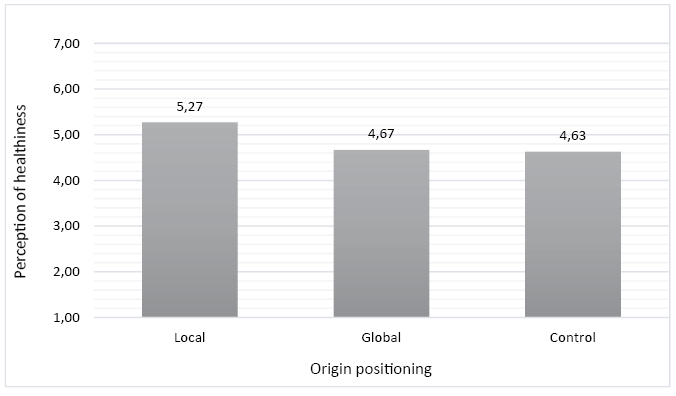
Figure 2
The Impact of Local vs. Global Cues on Willingness to Buy via Perception of Healthiness
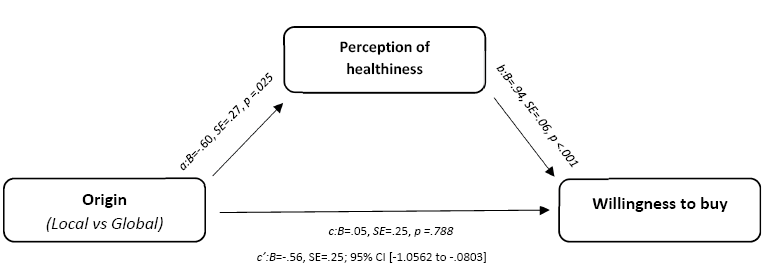
Next, the impact of perception of healthiness on willingness to buy was investigated. A mediation analysis (Hayes, 2017; PROCESS; Model 4, 5000 boot-strapped samples) with origin as the independent variable (dummy coded, 0 = local; 1 = global), perception of healthiness as the mediator, and willingness to buy as the dependent variable shows that, corroborating the analysis above, the global origin cues decrease perception of healthiness as compared to the local origin cue (B = -.60, SE = .27, t(145) = -2.26, p = .025). In turn, perception of healthiness increases willingness to buy a product (B = .94, SE = .06, t(144) = 15.38, p < .001). Importantly, to assess whether the impact of origin on buying intentions is mediated by perception of healthiness, the indirect effects were assessed. The analysis shows that the impact of origin on buying intentions was indeed mediated by perception of healthiness as the 95% confidence interval did not include zero (effect = -.56, 95% CI [-1.0562 to -.0803]) (see Figure 2). The direct effect of the origin (local versus global) to purchase intention was non-significant (p = .788). Thus, perception of healthiness fully mediates the relationship between the origin and willingness to buy. In support of H2, the results show that global (vs. local) positioning decreases perception of healthiness and, in turn, impacts willingness to buy.
Discussion. Experiment 1 provides initial evidence that global origin cues decrease consumers’ perception of healthiness compared to local origin cues. These findings confirm H1. Also, the results of this experiment show that there are no significant differences in healthiness evaluations between global origin positioning and control conditions. Therefore, in the context of healthiness evaluations, both strategies – emphasizing globalness and saying nothing about the products’ country of origin–are inferior to local origin positioning. Moreover, this experiment revealed that the global positioning of food products negatively affects consumers’ buying intentions through perception of healthiness (H2). Experiment 2 seeks to look more deeply into this phenomenon and better understand how it relates to consumers’ choices.
2.3 Experiment 2
Method and measures. Data were collected in a lab of a business school in Lithuania. Ninety-three participants from a professional research agency panel (Mage = 37.71 years, 66.7% female) participated in the experiment in exchange for bonus points. The experiment was conducted in three different between-subject experimental conditions where the origin of the fictitious product was manipulated. The local condition (1) included a descriptive story about a new product – fruit tea made only from domestic fruit, and the foreign condition (2) had a descriptive story about a new fruit tea made from fruit originating only from Switzerland. In the global condition (3), the fruit came from different countries across the world. Measurement of perceptions of healthiness (Cronbach’s α = .92; M = 4.74; SD = 1.40) and willingness to buy (Cronbach’s α = .90; M = 3.89; SD = 1.77) was used identically to Experiment 1.
Results. To assess whether the manipulation was successful, participants were asked to evaluate the likelihood that the product’s ingredients came from different countries all over the world. The results confirmed that the manipulation was successful. Participants evaluated that it was more likely that ingredients of the fruit tea came from various countries in the global condition (Mglobal = 6.16, SDglobal = 1.14) than the local (Mlocal = 2.69, SDlocal = 1.78, t(65) = 9.41, p < .001) or foreign (Mforeign = 3.15, SDforeign = 2.11, t(56) = 6.91, p < .001). A univariate test shows that perception of healthiness of the food product varied across the conditions (Mlocal = 5.47, SDlocal = 1.12; Mforeign = 4.72, SDforeign = 1.41, Mglobal = 3.95, SDglobal = 1.27; F(2,90) = 12.26, p < .001) (see Figure 3). Analyses showed that participants perceived the fruit tea in the global condition as less healthy compared with the fruit tea in the local (Mlocal = 5.47; SDlocal = 1.12 vs Mglobal = 3.95; SDglobal = 1.27; t(65) = 5.22, p < .001) and also foreign conditions (Mforeign = 4.72, SDforeign = 1.41; t(56) = 2.19, p = .033). Moreover, the results of this experiment replicate the primary healthiness bias effect (Gineikiene et al., 2016) and show that there are significant differences between local and foreign origin positioning in healthiness evaluations (t(59) = 2.32, p = .024). In line with Experiment 1, these results confirm H1.
Figure 3
The Impact of Origin Cues on Perception of Healthiness
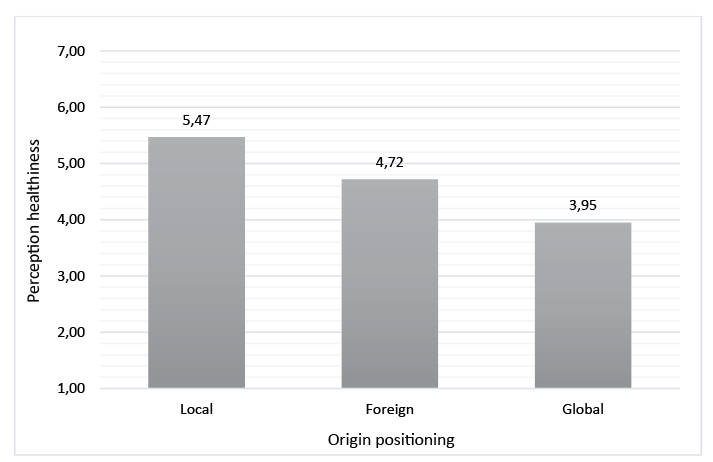
Figure 4
The Impact of Local vs. Global Cues on Willingness to Buy via Perception of Healthiness
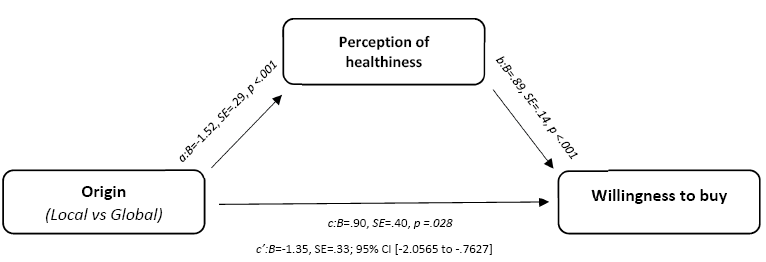
Next, the results of Experiment 2 show that the perception of healthiness indeed mediates the relationship between the origin cue of the product and the willingness to buy. Using Hayes’ (2017) PROCESS macro Model 4 with 5000 boot-strapped samples, the mediating effects of local vs. global positioning (dummy coded, 0 = local; 1 = global) were assessed. Replicating the findings of the previous experiment, results of this experiment show that global positioning decreases perception of healthiness as compared to local positioning (B = -1.52, SE = .29, t(65) = -5.22, p < .001). In turn, healthiness evaluations increase willingness to buy the product (B = .89, SE = .14, t(64) = 6.22, p < .001). The indirect effects analysis shows that the impact of origin (local versus global) on buying intentions was mediated by perception of healthiness as the 95% confidence interval did not include zero (effect = -1.35; 95% CI [-2.0565 to -.7627] (see Figure 4). The direct effect of the origin (global versus local) to purchase intentions is significant (p = .028). Thus, the results show that global (vs. local) positioning decreases perception of healthiness and, in turn, impacts willingness to buy. These findings confirm H2.
Discussion. Empirical analyses of Experiment 2 confirm the findings of Experiment 1 with another type of food product (fruit tea) that global origin cues are indeed related to lower perception of healthiness of the product (H1). In turn, it impacts consumers’ willingness to buy such a product (H2). Moreover, this experiment shows a conceptual distinction between foreign and global origin positioning, which is consequently related with significant differences in perception of healthiness of the product. Results provide empirical evidence that healthiness evaluations of food products associated with foreign origin are in the middle between local and global conditions assessments. Next, Experiment 3 seeks to look more deeply into explaining healthiness bias phenomena and better understand under which conditions consumers perceive global food products as less healthy.
2.4 Experiment 3
Method and measures. Sixty-three undergraduate students from a Lithuanian business school (Mage = 20.81, 58.7% female) participated in the experiment in exchange for partial course credit. In this experiment, manipulation of the origin differed from Experiment 1 and Experiment 2, and more focus was placed on availability cues of the product. As part of a larger experiment, two different experimental conditions were used, where the origin availability positioning message of the products was manipulated. Participants were introduced to a descriptive story about a new fictitious, made-in-France yogurt which is exclusively available and promoted only in the Lithuanian market in the local condition (1) versus a yogurt that is available and promoted as global in many countries all over the world in the global condition (2). Perceptions of healthiness (Cronbach’s α = .95; M = 4.88; SD = 1.68) were measured with the same three-item scale as in Experiment 1 and Experiment 2. Disease avoidance was measured with a three-item scale (adopted from Duncan et al., 2009), 1 = totally disagree, 7 = totally agree, Cronbach’s α = .86, M = 3.09, SD = 1.44).
Results. To assess the manipulation of origin, participants were asked to evaluate the likelihood that this product is available in many different countries around the world (as a globalness cue). The results showed that the manipulation was successful. Participants evaluated that the yogurt in the global condition is indeed available in many different countries (Mglobal = 4.20, SDglobal = 2.02) compared to the yogurt in the local condition (Mlocal = 2.67, SDlocal = 1.80, t(61) = 3.19, p = .002). In line with the results of Experiment 1 and Experiment 2, data analyses show that participants perceived the food product in the global condition as less healthy compared to the equivalent food product in the local condition (Mglobal = 4.44, SDglobal = 1.97, Mlocal = 5.27, SDlocal = 1.28, t(61) = 2.00, p = .050).
Next, the moderation effect of disease avoidance in the relationship between origin cue and perception of healthiness was tested. Using Hayes’ (2017) PROCESS macro Model 1 with 5000 boot-strapped samples, the moderation effects of local vs. global positioning (dummy coded, 0 = local; 1 = global) show that the interaction was significant (B = -.59, SE = .30, t(59) = -2.01, p = .049). Participants who evaluated themselves as vulnerable to disease evaluated food products in global conditions as less healthy than the same food product in local conditions. However, when participants perceived themselves as less vulnerable to disease, evaluations in perception of healthiness between global and local origin cues diminished (see Figure 5).
Figure 5
The Moderation Impact of Disease Avoidance on the Relationship between Origin Cue and Perception of Healthiness
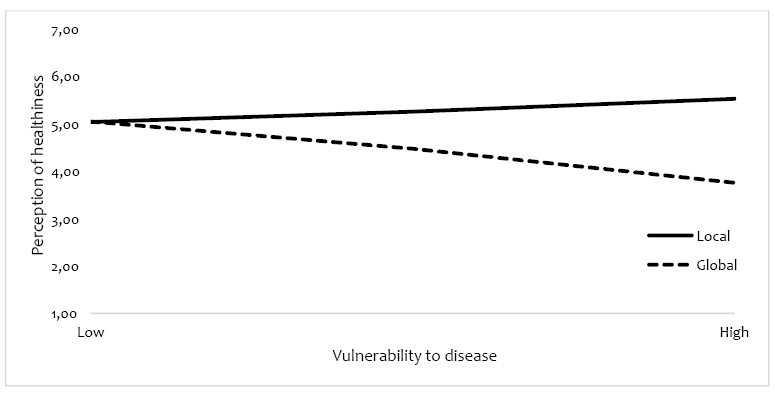
Discussion. Experiment 3 provides empirical evidence that the healthiness bias effect works with another type of a food product (yogurt) and confirms that consumers perceive global food products as less healthy than equivalent local food products (H1). Moreover, the results of this experiment provide a fruitful empirical explanation of this phenomenon by the moderation effect of disease avoidance. Data analyses show that consumers who are vulnerable to disease perceived global food products as less healthy than equivalent local food products. However, when consumers perceive themselves as not susceptible to disease, differences in evaluations of a product’s healthiness become non-significant. The findings of this experiment set boundaries for the healthiness bias phenomenon and explain why a global food product positioning strategy could be denominated considering the healthiness issue.
3. Theoretical Discussion and Implication
Research literature shows that the concept of globalness is related to contradictory findings, and consumers may have both positive (Bartsch et al., 2016) and negative predispositions towards associated global products (Alden et al., 2013). This research helps resolve some of these mixed findings and provides a better understanding of conditions when consumers may avoid global food products.
The current research contributes to the findings on the healthiness bias phenomenon and explores it in the global food products category. The data of three different experiments with three different kinds of food products (strawberry smoothie, fruit tea, and yogurt) confirm that global food products suffer from a healthiness bias effect – consumers’ tendency to favor local food products. Previous research shows that healthiness bias effects exist in local versus foreign origin groups (Gineikiene et al., 2016). This paper conceptually distinguishes foreign and global origin categories and shows that global origin suffers from an even greater negative effect of healthiness bias than products associated with a foreign or local origin.
From a theoretical perspective, this research contributes to international marketing and global branding literature and helps to better understand consumers’ evaluations and intentions in the global food products category. Drawing from arguments on cue utilization theory (Jacoby et al., 1971) and the categorization process of social cognition (Fiske, 2000), global food products are evaluated as less healthy because they are associated with an out-group category in consumers’ consciousness. In many cases, the global origin is associated with many different countries, but at the same time, there is a lack of information about specific countries or origins of the product. Consumers tend to avoid an unfamiliar origin (Peng et al., 2013). Moreover, previous research argues that the superordinate origin category fails in competition with local origin positioning (Diamantopoulos et al., 2017). Thus, this could be one of the reasons why a global origin is related to an even bigger avoidance evaluation than a foreign origin, which also belongs to the out-group category (Gineikiene et al., 2016).
Contributing to consumers’ behavior discipline, results of this research show that the perception of healthiness of global products impacts consumers’ buying intentions. Empirical evidence argues that consumers evaluate global food products as less healthy compared to equivalent local food products, which, in turn, decreases consumers’ willingness to buy such a product. This mediation effect of perception of healthiness was observed in different data samples with two different products of food (smoothie and fruit tea) in Experiment 1 and Experiment 2.
This research provides the first empirical evidence that the healthiness bias phenomenon is moderated by disease avoidance. Consumers who perceive themselves as vulnerable to disease express a significantly greater healthiness bias and perceive food products with global origin cues as less healthy than local ones. However, when consumers scored low on the disease avoidance scale and indicated that they had a low possibility of being vulnerable to disease, the differences in perception of healthiness diminished. These findings contribute to the existing knowledge and set the boundaries of the healthiness bias phenomenon.
4. Managerial Implications
The findings of this research provide several important implications for managers. While the variety of previous research focuses on the positive effect of globalness and emphasizes the competitive advantages of being global (Özsomer & Altaras, 2008; Dimofte et al., 2010; Alden et al., 2013; Steenkamp et al., 2003), this paper argues that in some cases, a global positioning strategy may be related to negative consumer evaluations.
First, healthiness bias phenomenon suggests that managers should pay attention and carefully choose positioning strategies for food products. Despite global products being attributed with a higher quality (Dimofte et al., 2008), prestige, or higher status (Kapferer, 1997), it could backfire when considering the product’s healthiness. This research shows that emphasizing the globalness of the product without any links to specific countries or regions leads to negative evaluations of food products via perception of healthiness compared to identical local or foreign food products. Moreover, based on the empirical evidence, this negative evaluation of global (versus local) product healthiness impacts consumers’ intentions to buy such food products. Thus, choosing the proper marketing and positioning strategy may help a brand to be viewed as an in-group member in consumers’ consciousness and get competitive advantages in the market.
Second, based on the findings of this research, healthiness bias did not occur for all consumers. Those who perceive themselves as vulnerable to disease tend to evaluate food products associated with global origin cues as less healthy than the local ones. However, there are no significant differences in healthiness evaluations for consumers who are not vulnerable to disease. Thus, these findings may help managers to not only choose a positioning strategy but also to segment and target. Focusing on a specific group of potential consumers and sending the right marketing message may lead to a more favorable product evaluation.
Next, this research shows that the globalness of food products could be manipulated in different ways. There are legal requirements of “made-in” information on the label of food products, which usually refers to one specific country of origin. However, companies may emphasize the globalness of food products in different ways. In this research, different manipulations of global origin were used, such as ingredients of the food product coming from various countries all around the world or the product being available worldwide in multiple countries around the globe. Highlighting the globalness of the product in marketing or positioning messages may reduce the impact of information about the specific “made-in” origin of the food product.
Finally, the findings on healthiness bias in the food product category can be helpful for policy-makers in trying to protect consumers’ rights and expectations. Consumers can choose products with an affiliation of “made-in” and associated with a specific local or foreign country. However, if the product’s ingredients come from different countries across the world, can this product really be associated with only one specific country of origin? Moreover, there are suggestions for extensive country of origin labeling requirements in the countries of the European Union, which specify the origin of a product’s primary ingredients (European Commission DG Health and Consumers, 2018).
5. Limitations and Directions for Future Research
Future research should consider several issues. First, in this research, global food products were defined and manipulated referring to the ingredients’ origin and availability cues. There are a plethora of definitions of global products in the literature (Cateora & Graham, 2007; Özsomer & Altaras, 2008; Steenkamp et al., 2003). Thus, different manipulations of globalness could be tested in future research, i. e., a combination of visuals or sounds associated with worldwide symbols, referring to famous people or events recognized all around the world, etc. Moreover, there could be different combinations of products’ country of origin, such as glocal (combination of global and local origin), gforeign (combination of a global and specific foreign country), as it remains unclear how consumers evaluate products with these kinds of origin.
Second, this research covers only the food products category, and healthiness bias was tested with only three specific food products (strawberry smoothie, fruit tea, and yogurt), which are usually considered as healthy or at least neutral food products. Previous research argued that the country of origin effect on consumers’ evaluations is activated at the product level (Krystallis & Chryssochoidis, 2009). Thus, differences in specific food products may be related to inconsistent results on the direct effect of the origin positioning on consumers’ willingness to buy, observed in Experiment 1 and Experiment 2. Also, it remains unclear how this healthiness bias phenomenon works with unhealthy or hedonic products. Moreover, the healthiness bias effect could also occur in different product categories, such as apparel (Gineikiene et al., 2016). Therefore, future research should explore the generalizability of these research findings and test how such a bias changes depending on different products and categories.
Third, empirical results of Experiment 3 provide arguments that vulnerability to disease (as the personal trait) moderates the relationship between origin positioning (local versus global) and healthiness evaluations of the product. However, this is only primary evidence that disease avoidance plays a moderator role in consumers’ perception of healthiness. Thus, to better understand this phenomenon, future research should consider replicating these findings with bigger samples and under different study conditions.
Next, this research used samples from one European country. Considering that cultural differences impact consumer behavior (Kim et al., 2002), future researchers may wish to explore whether the findings of this research also hold in different cultural settings.
Finally, individual differences and product experience may be at play when considering the strength of the healthiness bias. For example, purchase behavior differs for people new to a product category and those who are experienced and buy specific products regularly (Liefeld, 2004). Thus, it is expected that the healthiness bias would diminish with consumption experience. Moreover, brand equity strength and brand awareness may act as boundary conditions for the healthiness bias effect.
References
Akram, A., Merunka, D., & Akram, M. S. (2011). Perceived brand globalness in emerging markets and the moderating role of consumer ethnocentrism. International Journal of Emerging Markets, 6(4), 291–303. DOI:10.1108/17468801111170329.
Alden, D. L., Kelley, J. B., Riefler, P., Lee, J. A., & Soutar, G. N. (2013). The Effect of Global Company Animosity on Global Brand Attitudes in Emerging and Developed Markets: Does Perceived Value Matter? Journal of International Marketing, 21(2), 17–38.
Balabanis, G., & Diamantopoulos, A. (2004). Domestic Country Bias, Country-of-origin Effects, and Consumer Ethnocentrism: A Multidimensional Unfolding Approach. Journal of the Academy of Marketing Science, 32(1), 80–95.
Bartsch, F., Riefler, P., & Diamantopoulos, A. (2016). A Taxonomy and Review of Positive Consumer Dispositions Toward Foreign Countries and Globalization. Journal of International Marketing, 24(1), 82–110.
Batra, R., Ramaswamy, V., Alden, D. L., Steenkamp, J. B. E., & Ramachander, S. (2000). Effects of Brand Local and Nonlocal Origin on Consumer Attitudes in Developing Countries. Journal of Consumer Psychology, 9(2), 83–95.
Cateora, P., & Graham, J. (2007). International Marketing (13th ed). Boston, MA: McGraw-Hill Irwin.
Cervino, J., Sanchez, J., & Cubillo, J. M. (2005). Made in Effect, Competitive Marketing Strategy and Brand Performance: An Empirical Analysis for Spanish Brands. Journal of American Academy of Business, 6(2), 237–43.
Confer, J. C., Easton, J. A., Fleischman, D. S., Goetz, C. D., Lewis, D. M., Perilloux, C., & Buss, D. M. (2010). Evolutionary psychology: Controversies, questions, prospects, and limitations. American Psychologist, 65(2), 110.
Darwin, C. (1859). The Origin of Species and the Descent of Man. New York (The Modern Library).
De Mooij, M. (1998). The Theory behind Global Campaigns: A Review of Global Marketing & Advertising. ADMAP, 33, 48–48.
Davvetas, V., & Diamantopoulos, A. (2018). “Should Have I Bought the Other One?” Experiencing Regret in Global Versus Local Brand Purchase Decisions. Journal of International Marketing, 26(2), 1–21.
Davvetas, V., Diamantopoulos, A., & Liu, L. (2020). Lit Up or Dimmed Down? Why, When, and How Regret Anticipation Affects Consumers’ Use of the Global Brand Halo. Journal of International Marketing, 28(3), 40–63.
Davvetas, V., & Halkias, G. (2019). Global and Local Brand Stereotypes: Formation, Content Transfer, and Impact. International Marketing Review, 36(5), 675–701.
Diamantopoulos, A., Florack, A., Halkias, G., & Palcu, J. (2017). Explicit versus Implicit Country Stereotypes as Predictors of Product Preferences: Insights from the Stereotype Content Model. Journal of International Business Studies, 48(8), 1023–1036.
Dimofte, C. V., Johansson, J. K., & Ronkainen, I. A. (2008). Cognitive and Affective Reactions of US Consumers to Global Brands. Journal of International Marketing, 16(4), 113–135.
Duncan, L. A., Schaller, M., & Park, J. H. (2009). Perceived vulnerability to disease: Development and validation of a 15-item self-report instrument. Personality and Individual Differences, 47(6), 541–546.
European Commission DG Health and Consumers (2018), EU Law on Food Information to Consumers, (accessed 8 November 2021), [available at https://ec.europa.eu/food/safety/labelling-and-nutrition/food-information-consumers-legislation_en]
Faul, F., Erdfelder, E., Buchner, A., & Lang, A. G. (2009). Statistical power analyses using G* Power 3.1: Tests for correlation and regression analyses. Behavior Research Methods, 41(4), 1149–1160.
Faulkner, J., Schaller, M., Park, J. H., & Duncan, L. A. (2004). Evolved Disease-Avoidance Mechanisms and Contemporary Xenophobic Attitudes. Group Processes & Intergroup Relations, 7(4), 333–353.
Fiske, S. T. (2000). Stereotyping, prejudice, and discrimination at the seam between the centuries: Evolution, culture, mind, and brain. European Journal of Social Psychology, 30(3), 299–322.
Friedman, J. (1990). Being in the World: Globalization and Localization. Theory, Culture & Society, 7(2–3), 311–328.
Gaertner, S. L., Dovidio, J. F., Anastasio, P. A., Bachman, B. A., & Rust, M. C. (1993). The Common Ingroup Identity Model: Recategorization and the Reduction of Intergroup Bias. European Review of Social Psychology, 4(1), 1–26.
Gineikiene, J., Schlegelmilch, B. B., & Ruzeviciute, R. (2016). Our Apples are Healthier than your Apples: Deciphering the Healthiness Bias for Domestic and Foreign Products. Journal of International Marketing, 24(2), 80–99.
Griskevicius, V., & Kenrick, D. T. (2013). Fundamental motives: How evolutionary needs influence consumer behavior. Journal of Consumer Psychology, 23(3), 372–386.
Guo, X. (2013). Living in a Global World: Influence of Consumer Global Orientation on Attitudes toward Global Brands from Developed versus Emerging Countries. Journal of International Marketing, 21(1), 1–22.
Halkias, G., Davvetas, V., & Diamantopoulos, A. (2016). The Interplay between Country Stereotypes and Perceived Brand Globalness/Localness as Drivers of Brand Preference. Journal of Business Research, 69(9), 3621–3628.
Halkias, G., & Diamantopoulos, A. (2020). Universal dimensions of individuals’ perception: Revisiting the operationalization of warmth and competence with a mixed-method approach. International Journal of Research in Marketing, 37(4), 714–736.
Halkias, G., Florack, A., Diamantopoulos, A., & Palcu, J. (2021). Eyes Wide Shut? Understanding and Managing Consumers’ Visual Processing of Country‐of‐Origin Cues. British Journal of Management, 0, 1–15.
Hayes, A. F. (2017). Introduction to Mediation, Moderation, and Conditional Process Analysis: A Regression-Based Approach. Guilford Publications.
Heinberg M., Katsikeas, C. S., Ozkaya H. E, & M. Taube (2020). How nostalgic brand positioning shapes brand equity: differences between emerging and developed markets. Journal of the Academy of Marketing Science, 48(5), 869–890.
Jacoby, J., Olson, J. C., & Haddock, R. A. (1971). Price, brand name, and product composition characteristics as determinants of perceived quality. Journal of Applied Psychology, 55(6), 570.
Jo, M. S., Nakamoto, K., & Nelson, J. E. (2003). The shielding effects of brand image against lower quality countries-of-origin in global manufacturing. Journal of Business Research, 56(8), 637–646.
Johansson, J. K., Douglas, S. P., & Nonaka, I. (1985). Assessing the Impact of Country of Origin on Product Evaluations: A New Methodological Perspective. Journal of Marketing Research, 22(4), 388–396.
Johansson, J. K., & Ronkainen, I. A. (2005). The esteem of global brands. Journal of Brand Management, 12(5), 339–354.
Johnson, C. M., Sharkey, J. R., Dean, W. R., McIntosh, W. A., & Kubena, K. S. (2011). It’s who I am and what we eat. Mothers’ food-related identities in family food choice. Appetite, 57(1), 220–228.
Kapferer, J. N. (1997). Managing luxury brands. Journal of Brand Management, 4(4), 251–259.
Kim, J. O., Forsythe, S., Gu, Q., & Moon, S. J. (2002). Cross‐cultural consumer values, needs and purchase behavior. Journal of Consumer Marketing, 19(6),481–502.
Krystallis, A., & Chryssochoidis, G. (2009). Does the Country of Origin (COO) of Food Products Influence Consumer Evaluations? An Empirical Examination of Ham and Cheese. Journal of Food Products Marketing, 15(3), 283–303.
Liefeld, J. P. (2004). Consumer knowledge and use of country‐of‐origin information at the point of purchase. Journal of Consumer Behaviour: An International Research Review, 4(2), 85–87.
Luttrell, A., Petty, R. E., & Xu, M. (2017). Replicating and fixing failed replications: The case of need for cognition and argument quality. Journal of Experimental Social Psychology, 69, 178–183.
Navarrete, C. D., & Fessler, D. M. (2006). Disease avoidance and ethnocentrism: The effects of disease vulnerability and disgust sensitivity on intergroup attitudes. Evolution and Human Behavior, 27(4), 270–282.
Özsomer, A., & Altaras, S. (2008). Global Brand Purchase Likelihood: A Critical Synthesis and an Integrated Conceptual Framework. Journal of International Marketing, 16(4), 1–28.
Özsomer, A. (2012). The Interplay between Global and Local Brands: A Closer Look at Perceived Brand Globalness and Local Iconness. Journal of International Marketing, 20(2), 72–95.
Papadopoulos, N. (2004). Place branding: Evolution, meaning and implications. Place Branding, 1(1), 36–49.
Peng, M., Chang, L., & Zhou, R. (2013). Physiological and behavioral responses to strangers compared to friends as a source of disgust. Evolution and Human Behavior, 34(2), 94–98.
Pharr, J. M. (2005). Synthesizing Country-of-Origin Research from the Last Decade: is the Concept still Salient in an Era of Global Brands? Journal of Marketing Theory and Practice, 13(4), 34–45.
Putrevu, S., & Lord, K. R. (1994). Comparative and noncomparative advertising: Attitudinal effects under cognitive and affective involvement conditions. Journal of Advertising, 23(2), 77–91.
Salnikova, E., & Grunert, K. G. (2020). The role of consumption orientation in consumer food preferences in emerging markets. Journal of Business Research, 112, 147–159.
Schaller, M. (2006). Parasites, Behavioral Defenses, and the Social Psychological Mechanisms through Which Cultures Are Evoked. Psychological Inquiry, 17(2), 96–101.
Schaller, M., & Park, J. H. (2011). The Behavioral Immune System (and Why It Matters). Current Directions in Psychological Science, 20(2), 99–103.
Schuh, A. (2007). Brand strategies of Western MNCs as drivers of globalization in Central and Eastern Europe. European Journal of Marketing, 41(3/4), 274–291.
Steenkamp, J. B. E., Batra, R., & Alden, D. L. (2003). How perceived brand globalness creates brand value. Journal of International Business Studies, 34(1), 53–65.
Strizhakova, Y., & Coulter, R. A. (2013). The “green” side of materialism in emerging BRIC and developed markets: The moderating role of global cultural identity. International Journal of Research in Marketing, 30(1), 69–82.
Swoboda, B., Pennemann, K., & Taube, M. (2012). The Effects of Perceived Brand Globalness and Perceived Brand Localness in China: Empirical Evidence on Western, Asian, and Domestic Retailers. Journal of International Marketing, 20(4), 72–95.
Talukdar, D., & Lindsey, C. (2013). To Buy or Not to Buy: Consumers’ Demand Response Patterns for Healthy versus Unhealthy Food. Journal of Marketing, 77(2), 124–138.
Zeugner-Roth, K. P., Žabkar, V., & Diamantopoulos, A. (2015). Consumer Ethnocentrism, National Identity, and Consumer Cosmopolitanism as Drivers of Consumer Behavior: A Social Identity Theory Perspective. Journal of International Marketing, 23(2), 25–54.
Appendix A
Scenarios of Experiments
|
Scenario for Experiment 1 |
|
Local condition
|
|
Global condition
|
|
Control condition
|
|
Scenario for Experiment 2 |
|
Local condition
|
|
Foreign origin condition
|
|
Global origin condition
|
|
Scenario for Experiment 3 |
|
Local condition
|
|
Global condition
|
Appendix B
Measurement of Constructs
Table B1
Scales and Measurement of Constructs
|
|
Experiment 1 |
Experiment 2 |
Experiment 3 |
|
Perception of healthiness (adapted from Gineikiene et al., 2016) |
|||
|
Healthy |
α = 0.96 |
α = .93 |
α = .95 |
|
Natural |
|||
|
Useful for my body |
|||
|
Willingness to buy (adapted from Putrevu & Lord, 1994) |
|||
|
It is very likely that I will buy this smoothie/tea. |
α = 0.91 |
α = .87 |
NA |
|
I will purchase this smoothie the next time I need a product like this. |
|||
|
I will definitely try this smoothie/tea. |
|||
|
Disease avoidance (adapted from Duncan, Schaller, & Park, 2009) |
|||
|
In general, I am very susceptible to colds, flu and other infectious diseases. |
NA |
NA |
α = .86 |
|
If an illness is “going around”, I will get it. |
|||
|
My immune system protects me from most illnesses that other people get (reverse-scored). |
|||
Note. All items measured on 7-point Likert scales (1 - “totally disagree”, 7 - “totally agree”), NA – not assessed.







